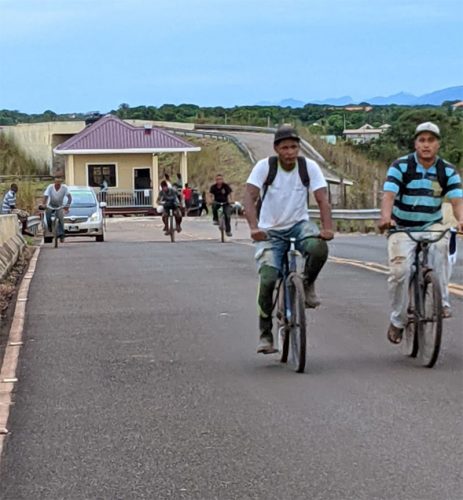The Lethem community, more particularly the business community there, appears hopeful rather than optimistic about the prospects of a Rupununi Rodeo being staged this year.
Another year without the customary financial ‘fix’ that the township gets from the Rodeo could create even greater challenges for a community that is already considerably economically depressed. Still no one seems inclined to place a meaningful bet on a rodeo this year. The portents afforded by the sustained menace of the COVID-19 pandemic does not allow for that level of optimism.
President of the Rupununi Chamber of Commerce, Daniel Gajie, prefers to proffer a more macrocosmic view of the township, it socio-economic circumstances and its future. Gajie is not inclined to ‘pull punches’. There is, he says, an urgent need for central government “to stop the haphazard planning that has been occurring in the Rupununi for several decades. There is need for a permanent development plan that can span approximately thirty years and continue whether or not there is a change in Ministers or Government.”

The Rupununi businessman cannot, he says, recall the number of “development plans” for the township that have been fashioned by government in collaboration with the private sector, over the years. “As Ministers and government change, they put aside the previous administration’s plan and put forward their own,” he adds.
He cites official attitudes to the flooding in large parts of the interior as a microcosm of a wider problem. “This is something that occurs regularly. In 2011 there was flood; in 2015 there was a flood; in 2019 there was a flood; afterwards they are sending the farmers back to the farm again, giving them cutlasses and cassava sticks and telling them to go and plant. There is no serious thought or commitment here.” There is no hint of equivocation in Gajie’s pronouncement.
Gajie makes no pretence about the fact that the traction possessed by the Rupununi Chamber of Commerce in its quest to influence state policy on the private sector and its role is wafer thin. “We have been lobbying for the past eighteen years for the development of a Lethem Industrial Site… but it has failed to start” he says, adding, “Never mind the fact that there were several businessmen who were ready to occupy the land.”
The absence of a coherent plan to enable the creation of a robust, locally-driven business community at Lethem has meant that, in large measure, Chinese and Brazilian entrepreneurial opportunists have stepped into the void. Gajie says that what commenced as a relative trickle “around 2007-2008” has now become an ‘open sepulchre.’ “They [the Brazilians] began by crossing the river on pontoons. It started with a few dozen Brazilians per day. Afterwards vehicles began to come across on the pontoons. They began to come in greater numbers, especially on weekends and on Brazilian holidays.
The operationalising of the Takatu Bridge in September 2009 opened the floodgate wider. “More Brazilians and Brazilian vehicles began crossing the bridge. At that time they came to shop in Lethem and there was a rise in Guyanese businesses,” Gajie explained.
Enter the Chinese… who, Gajie says arrived at Lethem well-prepared to respond to the surfeit of Brazilian demand for a range of consumer goods. He estimates that between 2010 and 2020 approximately twenty-seven Guyanese, Brazilian and Chinese businesses were established on the Barrack Retreat Road at Lethem. These he says, include, supermarkets, clothing stores, hardware stores and cosmetics and beauty stores. Ironically, the Rupununi Chamber President says, it is the Brazilians who ‘cross’ to Guyana that are the big spenders in these stores.
“Prior, to the pandemic, Lethem would see about one thousand Brazilians per day shopping in Lethem and that number increases during holiday. There is an influx of shoppers during Thursdays, Fridays, Saturdays and Sundays,” the Rupununi Chamber president told the Stabroek Business.
Nor is he reluctant to concede what he says has been the considerable marginalisation of local business enterprises which, on their own, can mount no effective response to what has been a Brazilian and Chinese invasion.
It is, Gajie believes, the historic leaden-footedness of central government over the years that has created a business environment at Lethem that places Guyanese businesses at a distinct disadvantage. Setting aside the failure of the state, over several years, to create a convivial physical environment for Guyanese businesses, the high costs associated with moving goods from the coast to the hinterland have created a situation in which Guyanese businesses are simply unable to compete with the Brazilian and Chinese ‘invasions’.
Gajie recalls that under the Jagdeo administration a “Lethem commercial area was established, twenty four hour electricity was installed… the development of a maintenance programme started between Linden and Lethem. Subsequently, we got National Insurance Scheme, police services expanded to include a Certifying Officer. Previously, drivers had to travel to get that service,” the Chamber President told this newspaper. He also stated that under the previous administration the [Rupununi] Chamber was able to get the government to agree for it to commence the process of business registration in the community. “Previously, business owners had to travel to Suddie, Essequibo Coast, a trip that cost more than $100,000. These days, the business owners apply at the Chamber office and pay a small fee and within two weeks they have their business registration,” Gajie says.
He also alluded to the lobbying by the Rupununi Chamber of the Guyana Revenue Authority to provide a service directly to the Lethem community.
Part two of the recent coverage of Lethem will be published in the next issue of the Stabroek Business.





